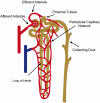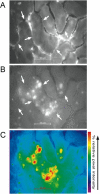Pharmacological targets in the renal peritubular microenvironment: implications for therapy for sepsis-induced acute kidney injury
- PMID: 22274552
- PMCID: PMC3319265
- DOI: 10.1016/j.pharmthera.2012.01.004
Pharmacological targets in the renal peritubular microenvironment: implications for therapy for sepsis-induced acute kidney injury
Abstract
One of the most frequent and serious complications to develop in septic patients is acute kidney injury (AKI), a disorder characterized by a rapid failure of the kidneys to adequately filter the blood, regulate ion and water balance, and generate urine. AKI greatly worsens the already poor prognosis of sepsis and increases cost of care. To date, therapies have been mostly supportive; consequently there has been little change in the mortality rates over the last decade. This is due, at least in part, to the delay in establishing clinical evidence of an infection and the associated presence of the systemic inflammatory response syndrome and thus, a delay in initiating therapy. A second reason is a lack of understanding regarding the mechanisms leading to renal injury, which has hindered the development of more targeted therapies. In this review, we summarize recent studies, which have examined the development of renal injury during sepsis and propose how changes in the peritubular capillary microenvironment lead to and then perpetuate microcirculatory failure and tubular epithelial cell injury. We also discuss a number of potential therapeutic targets in the renal peritubular microenvironment, which may prevent or lessen injury and/or promote recovery.
Copyright © 2012 Elsevier Inc. All rights reserved.
Figures






Similar articles
-
Development of oxidative stress in the peritubular capillary microenvironment mediates sepsis-induced renal microcirculatory failure and acute kidney injury.Am J Pathol. 2012 Feb;180(2):505-16. doi: 10.1016/j.ajpath.2011.10.011. Epub 2011 Nov 24. Am J Pathol. 2012. PMID: 22119717 Free PMC article.
-
Simvastatin improves sepsis-induced mortality and acute kidney injury via renal vascular effects.Kidney Int. 2006 May;69(9):1535-42. doi: 10.1038/sj.ki.5000300. Kidney Int. 2006. PMID: 16557230 Free PMC article.
-
Dexmedetomidine protects against lipopolysaccharide-induced sepsis-associated acute kidney injury via an α7 nAChR-dependent pathway.Biomed Pharmacother. 2018 Oct;106:210-216. doi: 10.1016/j.biopha.2018.06.059. Epub 2018 Jun 28. Biomed Pharmacother. 2018. PMID: 29960167
-
A unified theory of sepsis-induced acute kidney injury: inflammation, microcirculatory dysfunction, bioenergetics, and the tubular cell adaptation to injury.Shock. 2014 Jan;41(1):3-11. doi: 10.1097/SHK.0000000000000052. Shock. 2014. PMID: 24346647 Free PMC article. Review.
-
Renal tubular epithelial cells response to injury in acute kidney injury.EBioMedicine. 2024 Sep;107:105294. doi: 10.1016/j.ebiom.2024.105294. Epub 2024 Aug 22. EBioMedicine. 2024. PMID: 39178744 Free PMC article. Review.
Cited by
-
ZLN005 protects against ischemia-reperfusion-induced kidney injury by mitigating oxidative stress through the restoration of mitochondrial fatty acid oxidation.Am J Transl Res. 2021 Sep 15;13(9):10014-10037. eCollection 2021. Am J Transl Res. 2021. PMID: 34650679 Free PMC article.
-
Paclitaxel ameliorates lipopolysaccharide-induced kidney injury by binding myeloid differentiation protein-2 to block Toll-like receptor 4-mediated nuclear factor-κB activation and cytokine production.J Pharmacol Exp Ther. 2013 Apr;345(1):69-75. doi: 10.1124/jpet.112.202481. Epub 2013 Jan 14. J Pharmacol Exp Ther. 2013. PMID: 23318472 Free PMC article.
-
Role of Nrf2 in Lipopolysaccharide-Induced Acute Kidney Injury: Protection by Human Umbilical Cord Blood Mononuclear Cells.Oxid Med Cell Longev. 2020 Jul 28;2020:6123459. doi: 10.1155/2020/6123459. eCollection 2020. Oxid Med Cell Longev. 2020. PMID: 32774680 Free PMC article.
-
Inhibition of neddylation plays protective role in lipopolysaccharide-induced kidney damage through CRL-mediated NF-κB pathways.Am J Transl Res. 2019 May 15;11(5):2830-2842. eCollection 2019. Am J Transl Res. 2019. PMID: 31217857 Free PMC article.
-
Microparticles: markers and mediators of sepsis-induced microvascular dysfunction, immunosuppression, and AKI.Kidney Int. 2015 Jun;87(6):1100-8. doi: 10.1038/ki.2015.26. Epub 2015 Feb 18. Kidney Int. 2015. PMID: 25692956 Free PMC article. Review.
References
-
- Abrahamson DR, Leardkamolkarn V. Development of kidney tubular basement membranes. Kidney International. 1991;39:382–393. - PubMed
-
- Ader I, Malavaud B, Cuvillier O. When the sphingosine kinase 1/sphingosine 1-phosphate pathway meets hypoxia signaling: new targets for cancer therapy. Cancer Research. 2009;69:3723–3726. - PubMed
-
- Adlam VJ, Harrison JC, Porteous CM, James AM, Smith RA, Murphy MP, Sammut IA. Targeting an antioxidant to mitochondria decreases cardiac ischemia-reperfusion injury. FASEB Journal. 2005;19:1088–1095. - PubMed
-
- Al-Mashhadi RH, Skott O, Vanhoutte PM, Hansen PB. Activation of A(2) adenosine receptors dilates cortical efferent arterioles in mouse. Kidney International. 2009;75:793–799. - PubMed
-
- Allende ML, Yamashita T, Proia RL. G-protein-coupled receptor S1P1 acts within endothelial cells to regulate vascular maturation. Blood. 2003;102:3665–3667. - PubMed
Publication types
MeSH terms
Grants and funding
LinkOut - more resources
Full Text Sources
Medical

